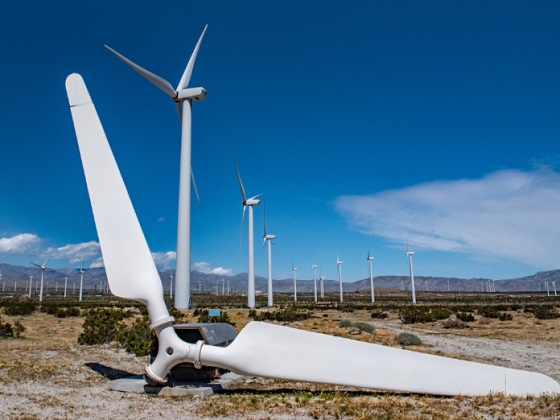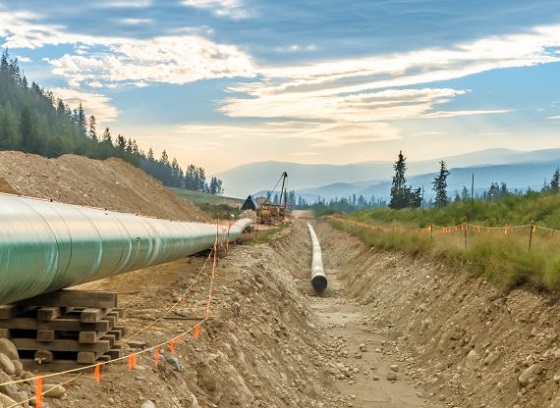Energy
Buckle Up for Summer Blackouts: Wind Is Already Failing Texas in Spring

From Heartland Daily News
By Jason Isaac
When the wind blows too much, natural gas plants are forced to shut down because they can’t underbid wind producers that can bid zero or negative. But when the wind doesn’t blow when it is needed, wind generators can afford the loss of revenue because they earn so much from tax subsidies.
It’s been all quiet on the electric grid front for a few months — but don’t get your hopes up. Over the last month, electricity prices came near the $5000/MWh regulatory cap three separate times because the wind wasn’t blowing enough when the sun went down.
If this sounds familiar, you’re not wrong.
You may hear from the drive-by media that the problem is unseasonably warm temperatures, or that there are a lot of power plants down for maintenance. But high 80s in April and low 90s in May are not unusual, and the Texas grid used to manage these weather changes with no problems. From 2014 to 2016, real-time prices only went over $1000/MWh twice, but it’s happened three times already this year.
If the grid is already on shaky ground, with many weeks to go before blistering triple-digit temperatures shoot electric demand through the roof, all signs are pointing to an unpleasant summer.
The problem with the Texas grid is so simple it’s infuriating: Relying too heavily on unpredictable wind and solar, without enough reliable reserve capacity, means higher volatility — leading to higher prices and increasing need for expensive interventions by ERCOT to avoid outages. This is why your electric bill is going up and up even though wind and solar are supposed to be cheap.
While Texas certainly has a lot of sun, peak solar output almost never aligns with peak electric usage. The Lone Star State also has plenty of wind, but wind generation is wildly unpredictable — by nature. It’s not unusual for a wind generator’s output to swing 60 percentage points or more in a single week.
Take last month, for example. On Tuesday, April 16, electricity prices reached their cap because ERCOT’s day-ahead wind forecast was off by 50%. Five gigawatts of wind we were counting on to power Texas as the sun went down didn’t show up. That was the equivalent of simultaneously shutting down 10 large natural gas units, or all of the state’s nuclear capacity. If the latter occurred, the news media would be up in arms (and rightfully so). But because the culprit was the political darling of both the left and the right, no one heard about it.

ERCOT hasn’t been the best at predicting wind output, and the problem isn’t entirely its fault. Wind veers so wildly between extremes it’s nearly impossible to plan a sustainable grid around its fickleness — yet wind makes up 26% of our generating capacity.
It’s all because lucrative tax breaks and subsidies at the state and federal level, combined with flaws in ERCOT’s market design, make it almost impossible for wind to lose money — and harder than ever for natural gas to compete, even though it’s far more reliable and affordable. When the wind blows too much, natural gas plants are forced to shut down because they can’t underbid wind producers that can bid zero or negative. But when the wind doesn’t blow when it is needed, wind generators can afford the loss of revenue because they earn so much from tax subsidies.
Imagine trying to open a restaurant when your competitor next door is paying its customers to eat there. It’s no wonder natural gas capacity in ERCOT has barely grown over the past decade, and not enough to make up for losses of coal plants, while demand has been steadily increasing.
All those subsidies are hurting our most reliable, affordable energy producers and putting our economy at risk — leaving you and me, the taxpayers on the hook.
While most political issues are far more complex and nuanced than brazen attack ads and headlines would lead you to believe, in this case, it really does boil down to one simple problem.
And it would be easy to solve — if lawmakers are willing to go against the grain of political correctness and set a clear reliability standard for the wind and solar generators that want to connect to our grid.
Unfortunately, that’s a gargantuan “if.”
As a former lawmaker, I understand the pressures our legislators are under to toe the line on alternative energy. Major utilities embracing World Economic Forum- and United Nations-aligned “energy transition” policies that seek to redefine what’s “clean” and what’s “pollution” are making matters worse. And the incessant misinformation from their well-funded lobby that promise rural “economic development” and “cheap energy” sound too good to be true, because they are.
Elected officials don’t serve the lobby. They serve Texans — or, at least, they should.
And Texans want a reliable, affordable grid. They want to not have to worry about losing power in the heat of the summer or the dead of winter. The Legislature must put a stop to these market-distorting subsidies and make reliability, not popularity, the priority for our electric grid.
Gov. Greg Abbott sent a letter on July 6, 2021 to members of the Public Utility Commission of Texas (PUC) directing them to “take immediate action to improve electric reliability across the state.” The second directive was to “Allocate reliability costs to generation resources that cannot guarantee their own availability, such as wind or solar power.” Unfortunately, the PUC hasn’t acted on this directive or even studied it. The costs of scarcity on the grid are estimated to have exceeded $12B in 2023, which is equal to two-thirds of the property tax relief passed in the 88th Legislature, all paid for by ratepayers.
“Unfortunately for Texans, the ERCOT grid is moving from a single grid with gas and coal power plants running efficiently all day to two grids: one for wind and solar and one for expensive backup power that fills in the gaps when there is not enough wind and sun,” says Dr. Brent Bennett, policy director for Life:Powered at the Texas Public Policy Foundation. “Every time these scarcity events occur, whether due to real scarcity or artificial scarcity created by ERCOT’s operating policies, ratepayers are shelling out tens to hundreds of millions of dollars for backup power. It is the most expensive way to operate a grid, and Texans will feel the bite as these costs are absorbed over time.”
The Californication of our grid is unfolding before our eyes. If the Legislature and the PUC don’t act fast, the Texas miracle won’t last.
The Honorable Jason Isaac is CEO of the American Energy Institute and a senior fellow at the Texas Public Policy Foundation. He previously served four terms in the Texas House of Representatives
Energy
75 per cent of Canadians support the construction of new pipelines to the East Coast and British Columbia

-
71 per cent of Canadians find the approval process too long.
-
67 per cent of Quebecers support the Marinvest Energy natural gas project.
“While there has always been a clear majority of Canadians supporting the development of new pipelines, it seems that the trade dispute has helped firm up this support,” says Gabriel Giguère, senior policy analyst at the MEI. “From coast to coast, Canadians appreciate the importance of the energy industry to our prosperity.”
Three-quarters of Canadians support constructing new pipelines to ports in Eastern Canada or British Columbia in order to diversify our export markets for oil and gas.
This proportion is 14 percentage points higher than it was last year, with the “strongly agree” category accounting for almost all of the increase.
For its part, Marinvest Energy’s natural gas pipeline and liquefaction plant project, in Quebec’s North Shore region, is supported by 67 per cent of Quebecers polled, who see it as a way to reduce European dependence on Russian natural gas.
Moreover, 54 per cent of Quebecers now say they support the development of the province’s own oil resources. This represents a six-point increase over last year.
“This year again, we see that this preconceived notion according to which Quebecers oppose energy development is false,” says Mr. Giguère. “Quebecers’ increased support for pipeline projects should signal to politicians that there is social acceptability, whatever certain lobby groups might think.”
It is also the case that seven in ten Canadians (71 per cent) think the approval process for major projects, including environmental assessments, is too long and should be reformed. In Quebec, 63 per cent are of this opinion.
The federal Bill C-5 and Quebec Bill 5 seem to respond to these concerns by trying to accelerate the approval of certain large projects selected by governments.
In July, the MEI recommended a revision of the assessment process in order to make it swift by default instead of creating a way to bypass it as Bill C-5 and Bill 5 do.
“Canadians understand that the burdensome assessment process undermines our prosperity and the creation of good, well-paid jobs,” says Mr. Giguère. “While the recent bills to accelerate projects of national interest are a step in the right direction, it would be better simply to reform the assessment process so that it works, rather than creating a workaround.”
A sample of 1,159 Canadians aged 18 and older were surveyed between November 27 and December 2, 2025. The results are accurate to within ± 3.5 percentage points, 19 times out of 20.
Business
Geopolitics no longer drives oil prices the way it used to

This article supplied by Troy Media.
Oil markets are shrugging off war and sanctions, a sign that oversupply now matters more than disruption
Oil producers hoping geopolitics would lift prices are running into a harsh reality. Markets are brushing off wars and sanctions as traders focus instead on expectations of a deep and persistent oil glut.
That shift was evident last week. Despite several geopolitical developments that would once have pushed prices higher, including the U.S. seizure of a Venezuelan crude tanker and fresh Ukrainian strikes on Russian energy infrastructure, oil markets barely reacted, with prices ending the week lower.
Brent crude settled Friday at US$61.12 a barrel and U.S. West Texas Intermediate at US$57.44, capping a weekly drop of more than four per cent.
Instead of responding to disruption headlines, markets were reacting to a different risk. Bearish sentiment, rather than geopolitics, continued to dominate as expectations of a “2026 glut” took centre stage.
At the heart of that outlook is a growing supply overhang. The oil market is grappling with whether sanctioned Russian and Iranian cargoes should still be counted as supply. That uncertainty helps explain why prices have been slow to react to a glut that is already forming on the water, said Carol Ryan, writing for The Wall Street Journal.
The scale of that buildup is significant. There are 1.4 billion barrels of oil “on the water,” 24 per cent higher than the average for this time of year between 2016 and 2024, according to oil analytics firm Vortexa. These figures capture shipments still in transit or cargoes that have yet to find a buyer, a clear sign that supply is running ahead of immediate demand.
Official forecasts have reinforced that view. Last week, the International Energy Agency trimmed its projected 2026 surplus to 3.84 million barrels per day, down from 4.09 million barrels per day projected previously. Even so, the IEA still sees a large oversupply relative to global demand.
Demand growth offers little relief. The IEA expects growth of 830 kb/d (thousand barrels per day) in 2025 and 860 kb/d in 2026, with petrochemical feedstocks accounting for a larger share of incremental demand. That pace remains modest against the volume of supply coming to market.
OPEC, however, has offered a different assessment. In its latest report, the group pointed to a near balance, forecasting demand for OPEC+ crude averaging about 43 million barrels per day in 2026, roughly in line with what it produced in November.
Reflecting that confidence. OPEC+ kept policy steady late in November, pausing planned output hikes for the first quarter of 2026 while more than three million barrels per day of cuts remain in place. Those measures are supportive in theory, but markets have shown little sign of being persuaded.
Recent geopolitical events underline that scepticism. The ongoing Russia-Ukraine war and Ukrainian strikes on Russian energy infrastructure, including reported hits on facilities such as the Slavneft-YANOS refinery in Yaroslavl, again failed to lift prices. Russia-Ukraine headlines pulled prices down more than strikes lifted them, according to media reports, suggesting traders were more attuned to “peace deal” risk than to supply disruption.
Washington’s move against Venezuelan crude shipments offered another test. The U.S. seizure of a Venezuelan tanker, the first formal seizure under the 2019 sanctions framework, had a muted price impact, writes Marcin Frackiewicz of Oilprice.com.
Venezuela’s exports fell sharply in the days that followed, but markets remained largely unmoved. One explanation is that Venezuela’s output is no longer large enough to tighten global balances the way it once did, and that abundant global supply has reduced the geopolitical premium.
Taken together, the signal is hard to miss. Oil producers, including in Canada, face a reality check in a market that no longer rewards headlines, only discipline and demand.
Toronto-based Rashid Husain Syed is a highly regarded analyst specializing in energy and politics, particularly in the Middle East. In addition to his contributions to local and international newspapers, Rashid frequently lends his expertise as a speaker at global conferences. Organizations such as the Department of Energy in Washington and the International Energy Agency in Paris have sought his insights on global energy matters.
Troy Media empowers Canadian community news outlets by providing independent, insightful analysis and commentary. Our mission is to support local media in helping Canadians stay informed and engaged by delivering reliable content that strengthens community connections and deepens understanding across the country.
-

 Business1 day ago
Business1 day agoArgentina’s Milei delivers results free-market critics said wouldn’t work
-

 Alberta2 days ago
Alberta2 days agoAlberta’s new diagnostic policy appears to meet standard for Canada Health Act compliance
-

 Health2 days ago
Health2 days agoRFK Jr reversing Biden-era policies on gender transition care for minors
-

 Business1 day ago
Business1 day agoGeopolitics no longer drives oil prices the way it used to
-

 Business1 day ago
Business1 day agoDeadlocked Jury Zeroes In on Alleged US$40 Million PPE Fraud in Linda Sun PRC Influence Case
-

 Censorship Industrial Complex2 days ago
Censorship Industrial Complex2 days agoCanadian university censors free speech advocate who spoke out against Indigenous ‘mass grave’ hoax
-

 Daily Caller2 days ago
Daily Caller2 days agoEx-FDA Commissioners Against Higher Vaccine Standards Took $6 Million From COVID Vaccine Makers
-

 COVID-192 days ago
COVID-192 days agoFreedom Convoy protester appeals after judge dismissed challenge to frozen bank accounts











